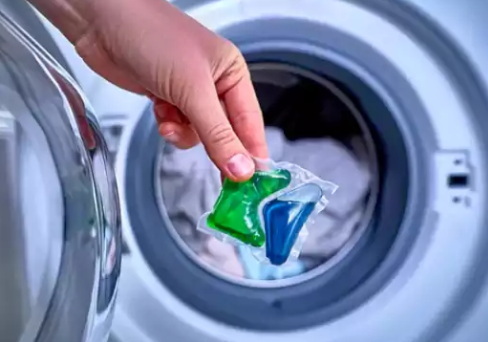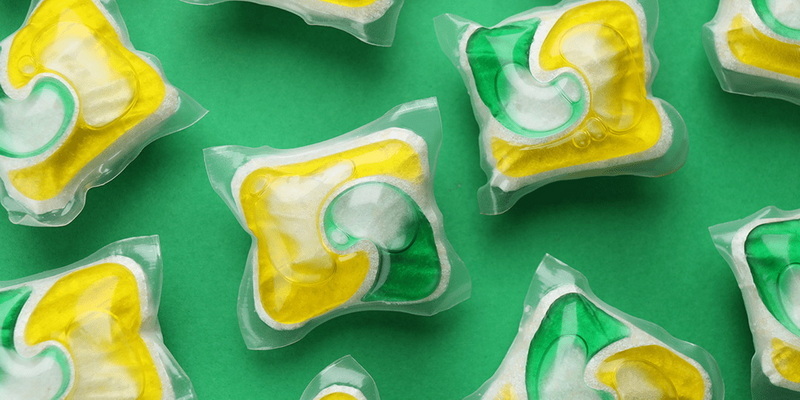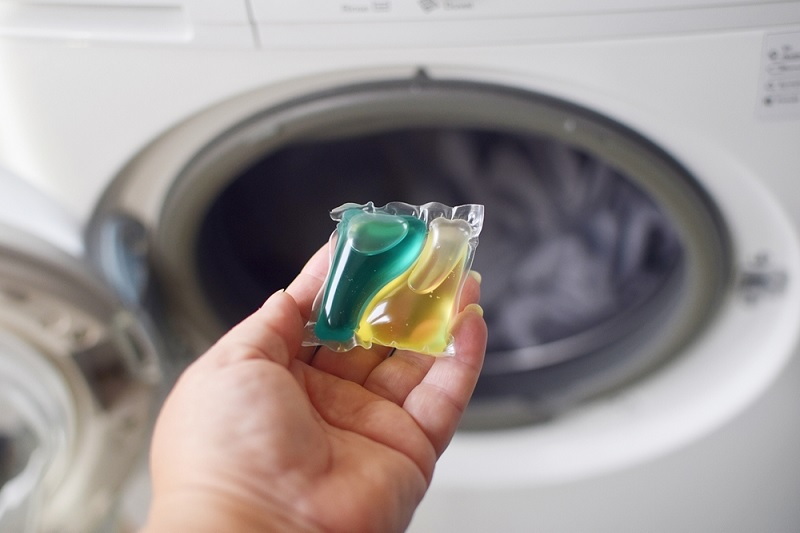Dongguan UFine Daily Chemical Co.,Ltd.
- All
- Product Name
- Product Keyword
- Product Model
- Product Summary
- Product Description
- Multi Field Search
Views: 222 Author: Tomorrow Publish Time: 10-29-2025 Origin: Site











Content Menu
● Overview
● Capacity planning and batch scaling
● Ethical and environmental considerations
● FAQ
>> 1. How long do homemade laundry pods last?
>> 2. Can I customize scents in homemade pods?
>> 3. What if a pod leaks during drying or storage?
>> 4. Are homemade pods safe for all washing machines?
>> 5. Can I use this method with a different shell material?
Making laundry pods at home can be a practical way to customize cleaning power, scents, and costs. This guide walks you through a safe, step-by-step process to create laundry pods using common household ingredients. It covers essential safety considerations, precise measurements, and storage tips to help you achieve effective and consistent results.

Laundry pods are small, concentrated capsules that hold a balanced combination of cleaning agents, surfactants, builders, and additives. The goal is to produce a single-use unit that dissolves in water, releasing cleaning agents evenly throughout a wash cycle. The method described here emphasizes accuracy, safety, and practicality, using readily available ingredients and equipment.
Homemade laundry pods can offer cost savings, reduce packaging waste, and enable customization for specific washing conditions such as hard water, delicate fabrics, or sensitive skin. However, creating pods requires careful handling of cleaning agents, precise dosing, and strict safety practices. This guide focuses on household-grade formulations suitable for typical domestic washing machines and everyday laundry needs, while highlighting potential risks and mitigations.
- Sodium carbonate (washing soda) for water softening and cleaning efficiency
- Sodium percarbonate for stain removal and whitening (acts as an oxygen bleach)
- Linear alkylbenzene sulfonate (or an equivalent mild liquid detergent) as the primary surfactant
- Polyvinyl alcohol (PVA) film or other food-grade, water-soluble film for pod shells
- Glycerin or water as a binding agent
- Optional additives:
- Sodium citrate as a water-softening booster
- Enzymatic stain removers or small amounts of a gentle fragrance for a preferred scent
- Colorants designed for safe cosmetic use (optional and careful use)
- Mineral salt stabilizers to improve dissolution consistency in varied water conditions
- Wear gloves and eye protection when handling powders and concentrated surfactants.
- Keep ingredients away from children and pets. Pods should be used with caution and stored securely.
- Use precise measurements to avoid chemical exposure and to ensure pod integrity.
- If you have sensitive skin or allergies, consider using fragrance-free formulations.
- Work in a well-ventilated area to minimize inhalation exposure to fine powders.
- Digital scale capable of measuring small quantities (grams)
- Mixing bowl and spoon or spatula
- Protective gloves and safety glasses
- Silicone mold or a shallow tray for shaping pods
- PVA film sheets or ready-made PVA pod shells
- Transparent tape or food-grade adhesive for sealing edges (optional)
- Airtight container for storage
- Dehydrator or a dry, room-temperature environment for drying pods (optional but recommended)
- Thermometer for monitoring ambient conditions during drying (optional)
A balanced pod formula typically combines cleaning power with stability. The following proportions are a starting point and can be adjusted after small-scale tests. This formulation is designed for a single, multi-purpose pod. The exact composition may be tuned based on performance in your washing machine and water conditions.
- Sodium carbonate: 15 g
- Sodium percarbonate: 15 g
- Liquid detergent: 10 g
- Sodium citrate: 5 g
- Water or glycerin binding agent: 5 g (adjust to achieve the right consistency)
- Optional fragrance: 1 g (use sparingly)
- PVA film for pod shells: sufficient to wrap each pod (the shell amount depends on pod size)
- Optional stabilizers: a pinch of salt (to help with dissolution in hard water) and a small amount of a chelating agent approved for household use
Note: The total dry weight should be consistent with the size of the pod you intend to create. For standard small pods, aim for a total weight around 40 g per pod including the shell material. If you prefer a lighter pod, scale down proportionally, ensuring the shell can still encapsulate the core blend securely.

1. Prepare your workspace and safety gear. Clean and dry all surfaces. Put on gloves and safety glasses.
2. In a mixing bowl, combine sodium carbonate, sodium percarbonate, and sodium citrate. Mix thoroughly to ensure even distribution.
3. If using an enzymatic stain remover, add it at this stage and blend uniformly. Ensure powders are fully incorporated to avoid clumping.
4. Add the liquid detergent. If using a liquid detergent, measure carefully to avoid adding too much moisture, which can weaken pod integrity.
5. Add the binding agent (water or glycerin). Mix until the blend holds together when pressed but is not sticky. The goal is a cohesive, moldable mass that does not crumble.
6. If using fragrance, incorporate it in small amounts to avoid overpowering scent and potential skin irritation.
7. Test a small pinch of the mixture. If it forms a cohesive ball that holds shape, it is ready to be wrapped. If it crumbles, add a little more binding agent gradually and mix again.
8. Prepare the PVA film or shell material. Cut sheets into appropriate pod-sized pieces if using film sheets you wrap around a core blend. Ensure edges are clean and ready for sealing.
9. Place a portion of the mixture onto a sheet and shape it into a pod, or place the core blend into the PVA shell and seal. Ensure edges are sealed well to prevent leakage. Use light pressure to form a uniform capsule shape.
10. Allow pods to dry thoroughly. Drying can be done at room temperature in a well-ventilated area or with a dehydrator. Drying may take 24–72 hours depending on humidity and film thickness. If using a dehydrator, monitor temperature to avoid premature shell softening.
11. Inspect for complete dryness and shell integrity. If any moisture remains, let the pods dry longer. If shells appear brittle, consider adjusting the moisture content in a future batch.
12. Store in an airtight container away from moisture and heat. Avoid exposing pods to direct sunlight or high humidity. For best results, keep in a cool, dry place with stable temperature.
- Small-batch testing (1–3 pods) helps assess dissolution, texture, and stability before scaling up.
- Once a batch passes dissolution and handling tests, scale by multiplying ingredients proportionally while maintaining the same shell-to-core ratio.
- If you plan to produce multiple pods at once, arrange a grid or tray system that ensures even drying and uniform shell coverage.
- Pod integrity: Each pod should have a sealed shell with no exposed powder inside.
- Dissolution: Pods should dissolve in water within a standard wash cycle without leaving visible residues.
- Safety: Do not ingest pods. Keep out of reach of children and pets. If contact with skin or eyes occurs, rinse promptly with water.
- Storage stability: Check for signs of shell degradation or moisture absorption after several weeks of storage. Reassess humidity conditions if deterioration is observed.
- Use one pod per standard wash load, unless the load is unusually large or heavily soiled.
- Place the pod directly into the drum before adding clothes, or per the shell instructions if using wraps.
- Do not unwrap pods unless you need to. The shell is designed to dissolve in water, releasing the core cleaning agents.
- For heavily soiled garments, consider pre-soak or adding an additional detergent dose, rather than increasing pod count.
- Follow local regulations for disposal of household chemical waste. Do not flush pods or broken shells into plumbing that could contaminate water sources.
- If a pod leaks in storage, transfer contents to a sealed container and inspect for compatibility issues with the shell material before reuse.
- If pods crumble during handling, increase the binding agent slightly and re-test.
- If pods take too long to dissolve, reduce the detergent amount or increase moisture tolerance with a small amount of water during shaping, then re-dry.
- If the shell leaks after sealing, reseal the pod with extra film and ensure a tight seal.
- If a batch produces dusty powder rather than cohesive pods, check for humidity levels and consider using a more robust shell or adjusting the crust thickness.
- Fragrance-free version for sensitive users: omit fragrance and use only essential cleaning agents.
- Enzyme-enhanced pods: add a small amount of enzyme-based stain remover to boost performance on protein-based stains.
- Hard-water optimized pods: increase sodium citrate slightly to improve performance in areas with high mineral content.
- Larger pods for bulk loads: adjust shell size and core weight proportionally, ensuring dissolution remains reliable.
- Aim to minimize plastic or wrapper waste by choosing fully dissolvable PVA shells.
- Avoid excessive use of surfactants that can cause foaming or environmental impact. Seek formulations with biodegradable components where possible.
- Be mindful of the potential for skin irritation in household use. Provide fragrance-free or hypoallergenic options.
Creating laundry pods at home can be a practical solution when performed with careful measurement and safety practices. A well-balanced blend of cleaning agents, a secure pod shell, and proper drying yields pods that dissolve reliably and deliver consistent cleaning power across loads. With diligent preparation, you can tailor ingredients to suit your washing needs while maintaining safety and efficiency.

Pods should be used within a few months if stored in a cool, dry place and kept in an airtight container. Avoid exposing them to moisture.
Yes. You can add a small amount of fragrance or use fragrance-free formulations to suit preferences and sensitivities. Use fragrances sparingly to minimize potential irritation.
If a pod leaks, reseal with additional shell material and ensure it is completely dry before storing. Check that the blend is sufficiently cohesive before re-wrapping.
Most standard washing machines can handle pod-form detergents, but always follow manufacturer recommendations. Ensure the pod is fully sealed to prevent leakage into the drum.
Yes. If you have access to alternative water-soluble shell films, adjust the wrapping method accordingly and test for dissolution rate and leak resistance.